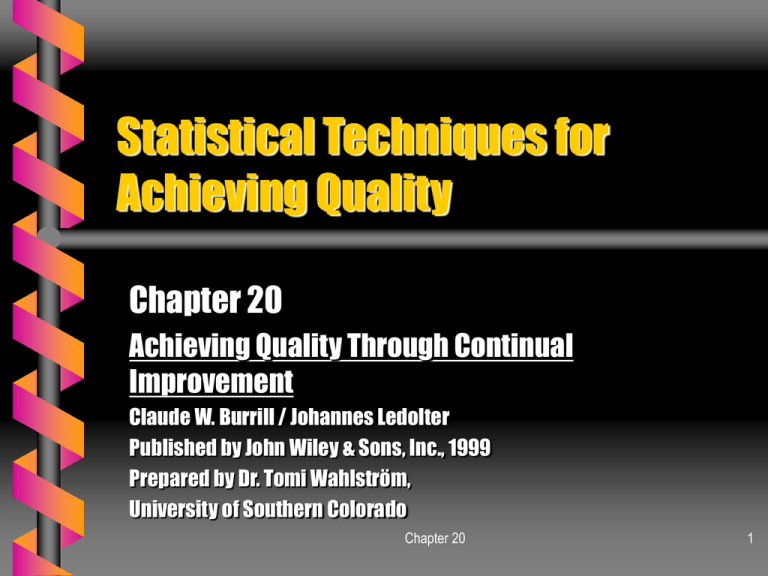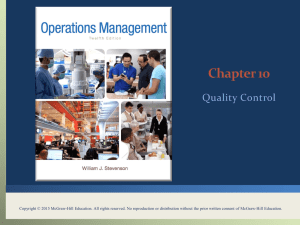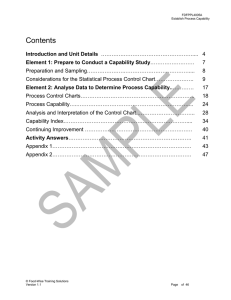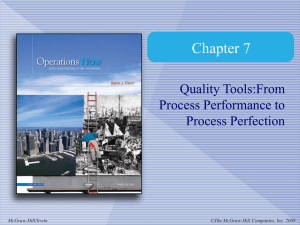
Statistical Techniques for
Achieving Quality
Chapter 20
Achieving Quality Through Continual
Improvement
Claude W. Burrill / Johannes Ledolter
Published by John Wiley & Sons, Inc., 1999
Prepared by Dr. Tomi Wahlström,
University of Southern Colorado
Chapter 20
1
Introduction
Statistical quality control is a branch of
applied statistics dealing with statistical
tools that help control the quality of
products and improve the processes
responsible for these products
Acceptance sampling plans rely on
samples of incoming or outgoing material
to decide whether a lot should be accepted
Chapter 20
2
Introduction
Control charts are important tools for
monitoring processes through the
products they produce
Statistical design of experiments and
experimentation may also be used as a part
of statistical quality control
Chapter 20
3
Sample Inspection
When it is not realistic to use census for
inspection, one must rely on sample
inspection
• Taking a small sample size n from each
shipment lot, inspecting the sampled items,
and counting the number of items meeting the
requirements
Chapter 20
4
Control Charts
Graphical tool used to understand the
production process and to help assure that
the quality of products produced by that
process is consistent (or stable) over time
Easy to explain and apply
• Raise important issues and force their
resolution
• Focus attention on process rather than product
Chapter 20
5
X-bar Charts
Also known as the mean chart
Used in situations where one measures a
continuous variable
Terms associated with it:
• Upper and lower control limits
• Stable process, constant cause system
• Assignable cause
Chapter 20
6
R-Charts
Also known as the range chart
Plots the ranges of samples taken over
time and monitors the variability of the
process over time
Both X-bar and R-charts are used whenever
we measure so called “variable” aspects of
a process
Chapter 20
7
Control Charts for Attribute Data
p-Charts
• Used to monitor the proportion of defective items
c-Charts
• Used to keep track of the number of defects or
flaws on a product
Both used for attribute data
• Data that describes the presence or absence of a
certain characteristic
Chapter 20
8
Process Capability
Typically, a product must meet certain
specifications called a target value (Tg),
lower specification limit (LSL), and an upper
specification limit (USL)
If the products meet the specifications, the
process is capable of producing according
to the given specifications
Capability Index (Cp)
Chapter 20
9
Statistical Design of Experiments
Information can be collected in an active or
passive manner and must be collected
according to an experimental plan
Important principles to consider:
• Randomization
• Blocking
– “Block whatever you can block, and randomize
whatever you can’t block.”
Chapter 20
10
Questions?
Chapter 20
11
Copyright© 1999 John Wiley & Sons Inc. All rights reserved.
Reproduction or translation of this work beyond that permitted
in section 117 of the United States Copyright Act without the
express written permission of the copyright owner is unlawful.
Request for further information should be addressed to the
permission department, John Wiley & Sons, Inc. The
purchaser may make back-up copies for his/her own use only
and not for distribution or resale. The Publisher assumes no
responsibility for errors, omissions, or damages, caused by the
use of these programs or from the use of the information
contained herein.
Chapter 20
12












